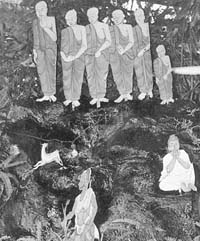 |
 7th June 1998 |
Front Page| |
Striving for the Four Noble TruthsBy Roy de Mel
The Four Noble Truths - (1) The first truth is Dukkha Sacca - Realising Dukkha (i.e. realising Anicca, Dukkha, Anatta) (2) The second truth is Samudaya Sacca - Eradicating Craving (3) The third truth is Nirodha Sacca - Realising Nibbana state (4) The fourth truth is Magga Sacca - Completion of the N.E.F. path by the occurrence of magga citta (path thought). The Nine Supramundane Dhammas are - 4 Magga cittas (path thoughts) 4 Phala cittas (fruition thoughts) 1 Nibbana The 4 Magga cittas and the 4 Phala cittas can be explained as follows- (1) When magga citta occurs for the first time, it is followed by sovan phala citta. (2) When maggga citta occurs for the second time, it is followed by sakadagami phala citta. (3) When magga citta occurs for the third time, it is followed by anagami phala citta. (4) When magga citta occurs for the fourth time, it is followed by arahatta phala citta. Now, let us examine the first of the four above stages. It is - "when magga citta occurs for the first time, it is followed by sovan phala citta". Now, when will magga citta occur for the first time? Answer is, magga citta being the fourth noble truth, magga citta will occur only after realising the first three noble truths. Hence it follows that - (1) One realises Sovan Phala citta only on realising the four noble truths for the first time. (2) Sakadagami level is reached on realising the four noble truths for the second time. (3) Angami level is reached on realising the four noble truths for the third time. (4) Arahat, the fully enlightened level is reached on realising the four noble truths for the fourth time. The Blessed One had realised all four stages in double quick time in one sitting itself. Some Arahats also have realised the four stages on the same day, and some during the same birth. However, the time from the first stage up to the fourth stage will vary depending on the individual, the maximum period being seven births. Sotapatti-phala level The first stage, sotapatti-phala level can be reached by the practice of insight meditation at a meditation centre. One has to observe the eight or the ten precepts and engage on insight meditation, being aware of all thoughts that come in. Thus, one will be covering factors number one to seven of the noble eight fold path. When one does this correctly, one reaches the eighth factor - right concentration, and becomes one who is treading on all eight factors at the same time, the eight factors being- (1) Right Seeing/Understanding .View- comes under wisdom (panna) (2) Right Thinking (3) Right Speech under virtue (sila) (4) Right Action (5) Right Livelihood (6) Right Effort (7) Right Mindfulness under concentration (samadhi) (8) Right Concentration When one practises insight meditation in the manner explained, one realises three ordinary wisdoms and nine by vipassana wisdoms to reach sothapatti-phala level, by realising the four noble truths for the first time, as given below. The three ordinary wisdoms- (1) That there is no "I" "Me" or a "Person" in this body of ours, and that it is only name and rupa (mind and matter). This is known as ditthi visuddhi (purity of view). It is the knowledge of mind and matter determination and is known as namarupa-pariccheda-gnana. (2) That we had been born earlier, and also there will be future births. This is known as kankhavitarana visuddhi, which is the right view and withered the defilement of doubt. It is known as knowledge of conditionality - (paccaya pariggaha gnana). (30) Commencement of realising Dukkha (Anicca, Dukkha, Anatta). It is termed as Magga magga gnana - dassana visuddhi which means the purity of the knowledge and vision regarding path and not path. It is known as mastering knowledge - Sammassana gnana. Nine vipassana wisdoms- (1) Realising the arising and falling of nama and rupa. This is known as Udayabbaya gnana. (2) Realising the wisdom of dissolution of nama and rupa. This is known as Bhanganupassana gnana. (3) Realising the wisdom of fearfulness of nama and rupa. This is known as Bhayatupatthana gnana. (4) Realising the wisdom of dangers of nama and rupa. This is Adinavapassana gnana. (5) Realising the wisdom of disgust with nama and rupa. This is Nibbidanupassana gnana. (6) Realising the wisdom of desire for deliverance from nama and Rupa. This is Munacittukammayata gnana. (7) Realising the wisdom for strong desire to and suffering. This is Patisankhanupassana gnana. (8) Realising the wisdom of equanimity about nama and rupa. This is Sankhara-rupekkha nana. Here one falls into the state of majjhima patipada (Middle Way). (9) It is at the ninth vipassana wisdom known as Anuloma nana, that one realises the first and the second noble truths for the first time. The first noble truth is realised with a vision in connection with anicca, dukkha or anatta, realising anicca, dukkha and anatta. This is realising the first noble truth anatta. This is realising the first noble truth for the first time. Realising the first noble truth for the first time, is followed by eradication of craving (1500 kilesas) temporarily. This is realising the second noble truth for that first time. Third noble truth Immediately after realising the second noble truth for the first time, the object of the mind which is generally name-rupa (ordinary thoughts) changes from nama-rupa to "nibbana state" as the object of the mind. Thus one experiences a glimpse of nibbana, realising nibbana for the first time in life. This is realising the third noble truth for the first time. This is known as Gottarabhu- nana. Fourth noble truth Nibbana being a supramundane state, one realises two supramundane thoughts whilst still in nibbana. The first supramundane thought is experiencing a bright silvery light like lightning. It's a sudden occurrence. This is known as "magga citta" or "magga nana". This is realising the fourth noble truth for the first time. It erases the first three fetters, namely self illusion (sakkaya ditthi), doubts (vicikiccha), indulgence in wrongful rites and ceremonies (siliabbataparamasa). Fruition thought (Phala citta) Immediately after realising the fourth noble truth for the first time, and whilst still in nibbana state, it is followed by a fruition thought. Here one realises a deep peace of mind, which had never been experienced before. After realising the fruition thought for a moment, the object of the mind changes from nibbana state to the normal thought process which is nama-rupa. The above occurrences have now changed the individual to sotapatti phala level, having realised the four noble truths for the first time, and the fruition thought (phala citta) for the first time. This individual has become an ariyapuggala on two occasions, that is while realising the two supramundane thoughts. He is assured of not being born in any of the lower states of vice namely - hell, animal state, hungry ghost and demon. He is assured of Arahatship in not more than seven births the maximum. A sotapati-phala puggala (stream winner) can reach sakadagami state by realising the four noble truths for the second time. He will be born only once in case he does not attain Arahatship. He has weakened two more-fetters - namely sense desires (Kamaraga) and ill-will (patigaha). One reaches the third stage Anagami by realising the four noble truths for the third time. He completely discards the above two fetters. He does not return to this world because be has no more desire for sensual pleasures. After death he is born in the 'Pure Abodes' (Suddhavasa), till he becomes a fully Enlightened One. The fourth stage Arahatship is reached by realising the four noble truths for the fourth time. He destroys the remaining fetters - namely, lust after life in Realms of Forms (Ruparaga) and Formless Realms (Aruparaga), Conceit (Mana), Restlessness (Uddhacca), and Ignorance (Avijja). After death he will not be re-born as he has attained Nibbana.
Telling the tale of Posson
|
||
 |
More Plus * Where singing is tough business
Front Page| News/Comment| Editorial/Opinion| Business| Sports | Mirror Magazine |
|
 |
Please send your comments and suggestions on this web site to |
|
 In
order to attain Nibbana, one has to realise the Four Noble Truths by treading
on the Noble Eight Fold Path preached by the Blessed One. Generally it
is said that when one realises the Four Noble Truths, one attains Nibbana.
However we have to go deep in to this matter to get at the real meaning
of this statement. It will be clearly understood by connecting the 4 Noble
Truths to the 9 Supramundane Dhammas.
In
order to attain Nibbana, one has to realise the Four Noble Truths by treading
on the Noble Eight Fold Path preached by the Blessed One. Generally it
is said that when one realises the Four Noble Truths, one attains Nibbana.
However we have to go deep in to this matter to get at the real meaning
of this statement. It will be clearly understood by connecting the 4 Noble
Truths to the 9 Supramundane Dhammas.
 The
Ven. Sri Sumangala Nayake Thero in an interview with The Sunday Times said,
"Poson Poya is a great day for us Buddhists." The Mahawamsa relates
that Buddhism was brought here by Arahat Mahinda on Poson day.
The
Ven. Sri Sumangala Nayake Thero in an interview with The Sunday Times said,
"Poson Poya is a great day for us Buddhists." The Mahawamsa relates
that Buddhism was brought here by Arahat Mahinda on Poson day.